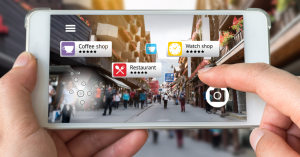If you’re not yet entirely familiar with the concept of augmented reality, then you’re about to be! This year promises to be a big year for this technology.
First of all, What is Augmented Reality (AR)?
AR is a live view of a physical, real-world environment with enhanced (or augmented) components added by computer-generated modalities. It turns a seemingly normal landscape, one that would happen in the real world, into a supernatural experience for the viewer. We can view augmented reality through smart glasses, handheld devices, heads-up displays (HUDs) and more.
Augmented reality made waves a few years back when games like Pokémon GO took the world by storm. But that was just the beginning for AR.
Although it wasn’t the first instance, the game worked as a propeller for the technology and made businesses aware of its potential and mass appeal. Since then, Apple, Google and Facebook have begun planning to integrate this technology with their products and services.
In fact, numerous companies are investing in AR, and not just because the technology is the latest ‘must have.’ They’ve realized the possibilities of AR, and the massive return it can generate.
So What Is the Big Deal with Augmented Reality?
Google’s ARCore, Apple’s ARKit, Snapchat’s Lens Studio – these are examples of big companies embracing augmented reality. When the big guys do something the rest tend to take notice! You can expect a lot of new products and services rolling out that integrate AR technology.
The potential goes far beyond the realms of entertainment or photo manipulation. Take the model of Pokémon GO, for example; instead of searching for digital monsters, you find the nearest defibrillator for someone who desperately needs it. Imagine that: AR as life-saving technology.
Related: Your New Co-Worker is a Bot | AI for Facebook CS
AR can also help retailers provide better, more personalized experiences to customers. Browse through clothing products and try them on virtually before making a purchase; pick out paint colors in your home without going to the store to buy samples. Or, maybe you’d like to see what a new sofa looks like in your living room, and save the trip to a furniture showroom.

Speaking of trips, tourism is another industry that should benefit from this technology. Imagine visiting the Colosseum and being able to see it as it was thousands of years ago.
Even schools can use augmented reality and integrate it into the curriculum and educational process. They can use this technology to present information in a fun, engaging way and make the learning process easier for everyone.
Augmented reality has a huge number of practical – and fun – applications that can improve life and the human experience. Unlike virtual reality, it does not rely on creating alternate universes. Instead, it builds around and improves what already exists by adding a few extra features into the mix.
A Final Thought
With any new technology that promises to change the world, there’s an inevitable wave of criticism, too. There are always those who are stuck in neutral, content with the status quo, or just don’t understand.
Popularizing AR (probably) won’t lead to a fully digitized world where human contact becomes obsolete, and everyone is in their own version of reality. However, the full potential of augmented reality is still not completely known, leaving huge opportunities for businesses to incorporate it into their marketing and overall strategy.
For example, did you know that there are ways to incorporate augmented reality into print pieces? If you think print AR could be a good fit your business and you want to learn more, then contact us at Ironmark today to speak with one of our experts.




